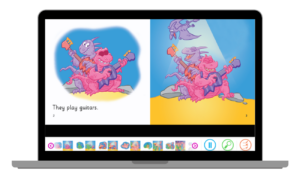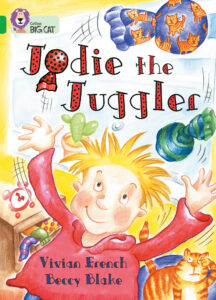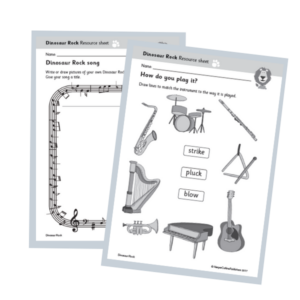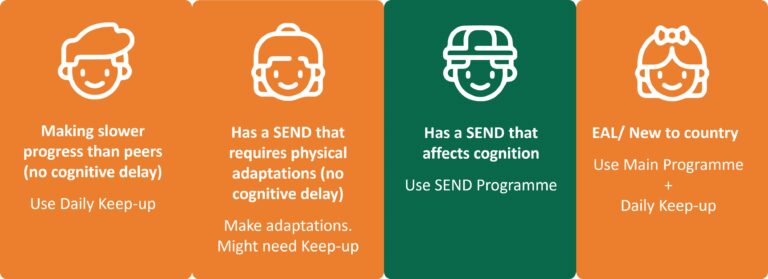Literacy expert Gill Matthews, shares some simple, enjoyable ideas for how parents can support their child’s reading comprehension and development at home. You may find this helpful to share with your pupils’ parents or you can adapt the ideas for your home learning plan.

Over 300 Collins Big Cat KS1 books are available as eBooks on the Collins Learn at Home web page. Why not take a look and use these ideas to help you make the most of this free on-line library? You can also apply these ideas to any books you have at home.
You don’t have to dive straight into a book. Take time to explore the covers with your child, spotting the title and the names of the author and illustrator, reading the back cover blurb (yes, that is a thing) and talking about what the book might be about. Ask:
- Have you read any other books by this author?
- Do you think it might be a story or maybe an information book?

If it is a non-fiction book, ask your child to tell you what they already know about the subject. Tell them what you know about the subject too. Discuss what you’d like to find out. Predicting the content of a book is an important reading skill because it activates the knowledge we already have about reading, about books, and about a particular type of book.
Here are some example discussion points you could ask:
- Read the title of this book to me
- What can you see on the front cover? (Leave the child to answer this in their own way. It will reveal their understanding of the subject matter of the book.)
- What do you think we’ll find in this book? (Again, leave your child to answer this and revisit their response once you’ve read the book.)
- Why do you think that? (Encourage your child to support their ideas with reasons.)
You can talk about the book together as you read it, to see if your expectations were right.

Once you’re into the book, you can vary how it is read. You can take it in turns to each read a page, you can ask your child to read it aloud to you (or someone else in the family), or, you can read it aloud to them.
When you are reading aloud, show how to read with expression and interest. This means taking notice of the punctuation, thinking about the meaning and with a story putting on voices when characters speak (remember – you’re not auditioning for drama school – just change your voice a little!)
When your child is reading, give them time to work out unfamiliar words rather than jumping in and telling them what it is. You can help by prompting them e.g. What sound does it start with? What sound comes next? Read the sentence again and think about what would make sense.
You could read the sentence aloud yourself, emphasising the unknown word, then ask your child to read the sentence themselves. In the Collins Big Cat eBooks, the text on each page is read aloud. You can choose to pause this until your child has read the text or to play it and encourage your child to read along.
Learning to read isn’t just about reading the words on the page. It’s also about understanding what is being read. So, in a story ask questions that encourage your child to predict what they think might happen next and to reflect on what has happened already. Be curious (ooh, I wonder what will happen now?) and keep questions open – in other words, ask questions that don’t produce just a yes/no answer. ‘How did you feel when …? rather than ‘Did you like …?’.

Here are some typical open questions that would support a chat about Collins Big Cat eBook Jodie the Juggler (Band Green):
- How did you feel when Jodie kept breaking things?
- What did you think would happen when Jodie kicked the ball on pages 16 and 17?
- How do you think Jodie felt when the football smashed some glass?
- Why do you think Mum said that juggling was a good idea?
Think about this as having a chat about the book rather than an interrogation. You can also use these prompts to help with your book chat:
- Tell me what you liked about the book
- Tell me about something you didn’t like
- Tell me about something that puzzled you or that you didn’t understand
- Tell me about something that this book made you think about or reminded you of
There are no right or wrong answers to these prompts so you can then respond to your child’s thoughts with your own ideas.
 If your child has enjoyed reading a book, why not try a few follow-up activities? If you look at the Collins Big Cat eBooks, under each picture of the book there is a ‘Resources’ button. Clicking on this will take you to a Worksheet and Teacher’s Notes. The worksheet can be printed off and completed. In the Teacher’s Notes, there is a section headed Checking and Moving on. This will give you some follow up ideas, many of which you can adapt for a home schooling situation. There are also suggestions of other Collins Big Cat books that are linked by subject matter or story type as well as some generic ideas that will work with many books. If you’ve read a story with your child, ask them to retell it or act it out together; if you’ve read a non-fiction book, ask them to write a fun fact sheet where they list their favourite three facts from the book, or encourage them to find out more about the subject of the book.
If your child has enjoyed reading a book, why not try a few follow-up activities? If you look at the Collins Big Cat eBooks, under each picture of the book there is a ‘Resources’ button. Clicking on this will take you to a Worksheet and Teacher’s Notes. The worksheet can be printed off and completed. In the Teacher’s Notes, there is a section headed Checking and Moving on. This will give you some follow up ideas, many of which you can adapt for a home schooling situation. There are also suggestions of other Collins Big Cat books that are linked by subject matter or story type as well as some generic ideas that will work with many books. If you’ve read a story with your child, ask them to retell it or act it out together; if you’ve read a non-fiction book, ask them to write a fun fact sheet where they list their favourite three facts from the book, or encourage them to find out more about the subject of the book.
Finally, in these unusual and often stressful times, keep reading fun and enjoyable. Try to read with your child at a time and in a place where they feel relaxed and secure. If they become bored or cross or upset – leave it and move on to something completely different.
Written by Gill Matthews
Gill Matthews is an education consultant specialising in the field of literacy. She runs training courses for teachers and has written a number of children’s books. Gill has written, edited and advised on a range reading schemes, including Collins Big Cat, and a variety of writing programmes.
 Collins Big Cat is a primary reading scheme packed with fantastic fiction and non-fiction by well-known authors and illustrators. Discover hundreds of banded readers, from Lilac to Pearl, to foster a love of reading in KS1 and KS2 children.
Collins Big Cat is a primary reading scheme packed with fantastic fiction and non-fiction by well-known authors and illustrators. Discover hundreds of banded readers, from Lilac to Pearl, to foster a love of reading in KS1 and KS2 children.
Find out more here.


